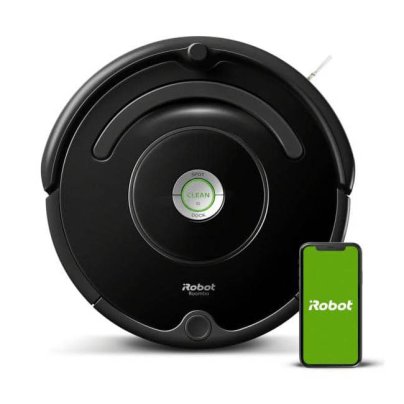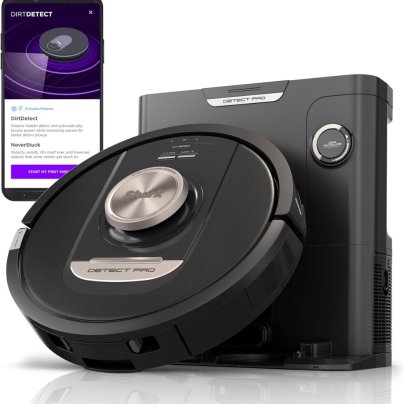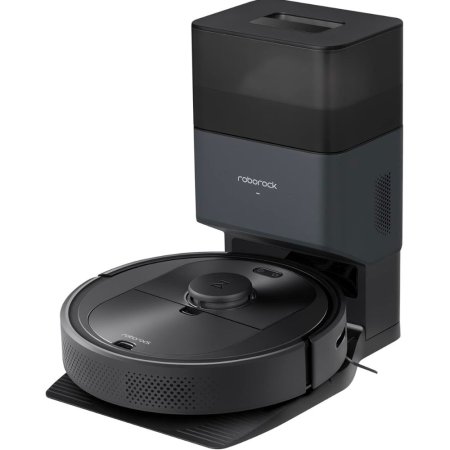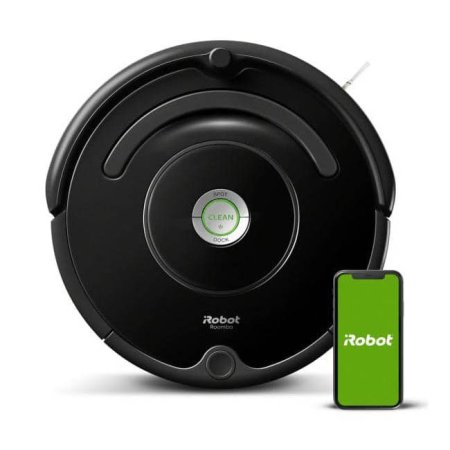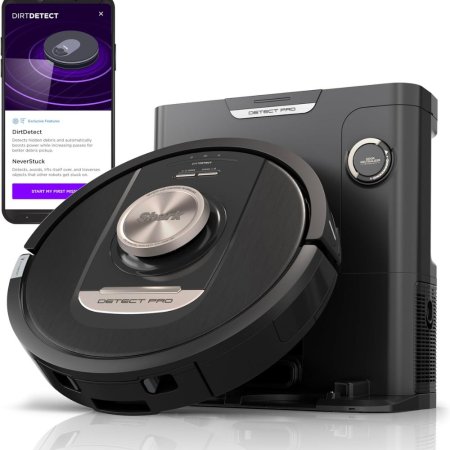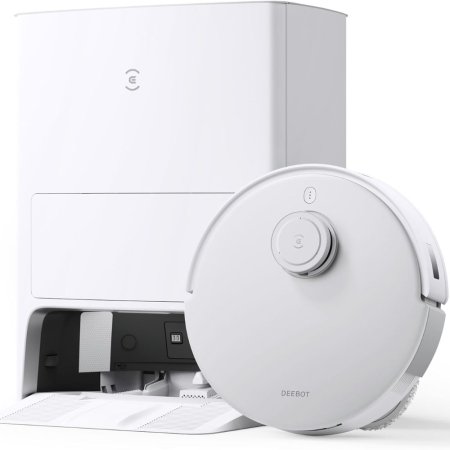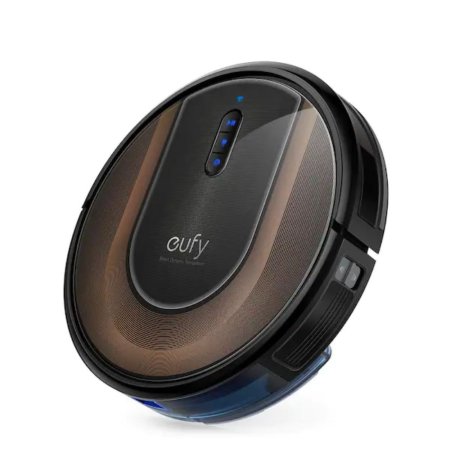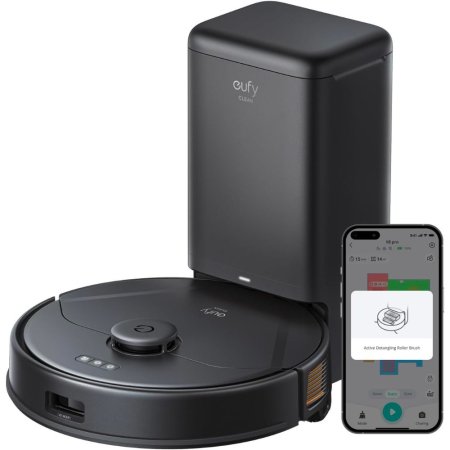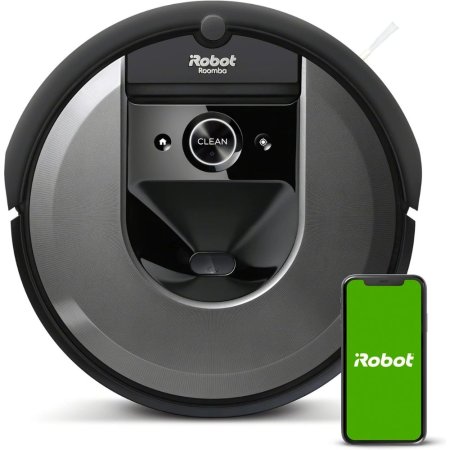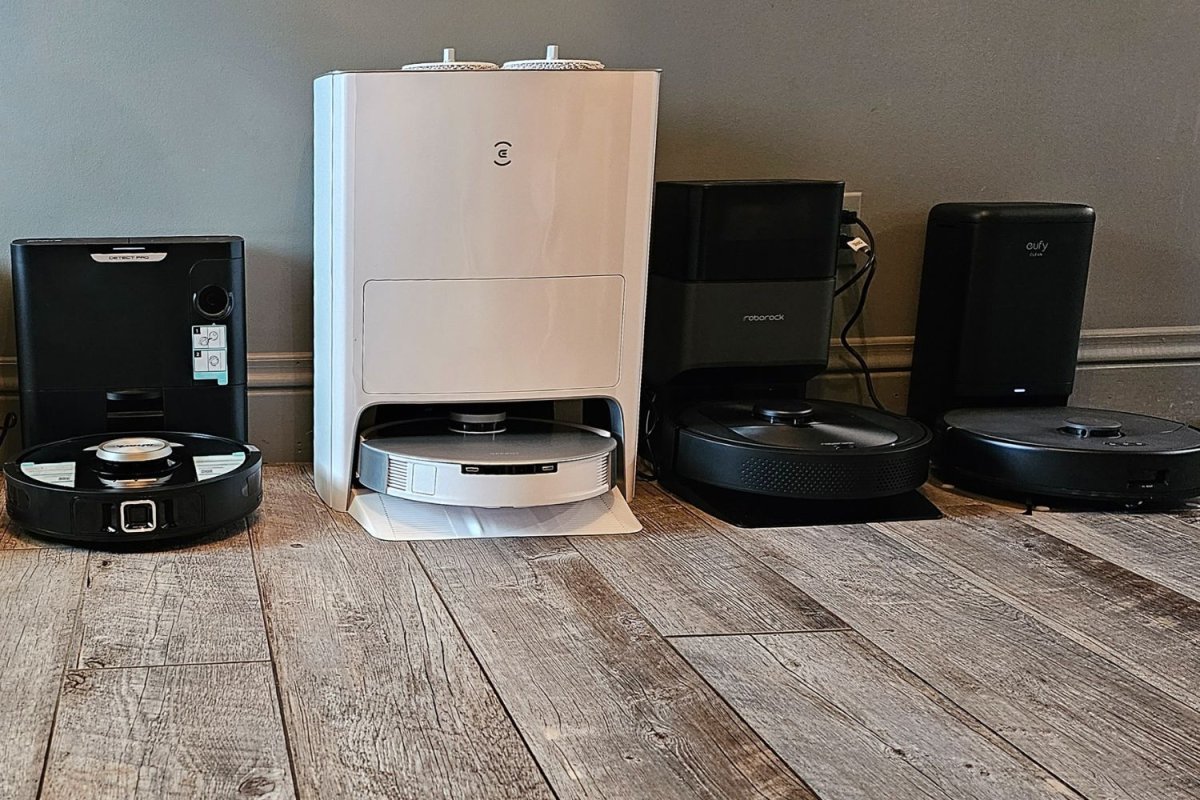
We may earn revenue from the products available on this page and participate in affiliate programs. Learn More ›
The advent of robot vacuums heralded a new era of more convenient carpet and hard floor cleaning. Robot vacuums have become increasingly advanced and well worth the investment for smart homes, gadget lovers, and anyone hoping to spend less time cleaning.
After carefully researching more than 25 top-selling models, we tested several high-tech robot vacuums in our own homes. Our goal? To determine how well different models cleaned and how straightforward they were to operate. Ahead, discover how the following models fared in our hands-on tests (pros and cons) and how they earned a spot on our lineup of the best robot vacuums.
- BEST OVERALL: Roborock Q5+ Robot Vacuum With Auto-Empty Dock
- BEST BANG FOR THE BUCK: iRobot Roomba 675 Wi-Fi Connected Robot Vacuum
- UPGRADE PICK: Shark Detect Pro Self-Emptying Robot Vacuum
- BEST WITH MOP: Ecovac Deebot Omni Robot Vacuum and Mop
- BEST FOR SMALL SPACES: Eufy by Anker G30 Edge Robot Vacuum
- BEST FOR LARGE SPACES: Eufy Clean X8 Pro Self-Emptying Robot Vacuum
- BEST FOR PET HAIR: iRobot Roomba i7 (7150) Smart Mapping Robot Vacuum
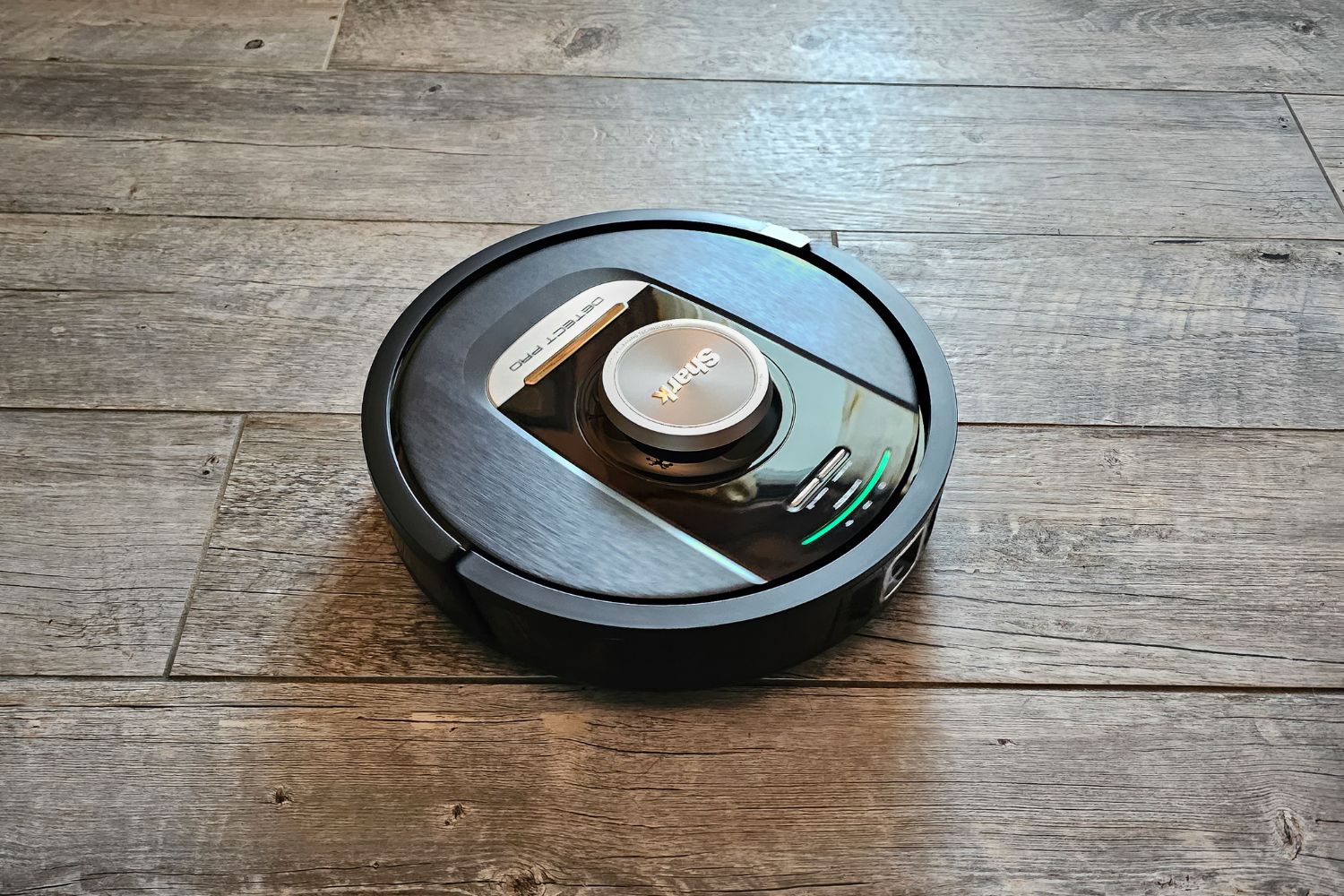
How We Tested the Best Robot Vacuums
We tested the robot vacuums in two pet-friendly homes—a 1-bedroom apartment with two people and two dogs; and a bustling rural residence with four dogs, two cats, and two humans. Testing took place on several types of flooring, including hard floors (wood, linoleum, and tile), carpet, and area rugs.
We tested each vacuum similarly, charging it fully and seeing how well it picked up sprinkled flour (to simulate dust), grains of rice, and breadcrumbs. We also created an obstacle course to see how well each vacuum could navigate around large objects like furniture and such smaller items as socks, barrier tape, and wires.
In addition, we tested the smart features, downloading the apps and syncing them via Bluetooth or Wi-Fi. If the robot vacuum came with a mopping function, we tested that, too. Finally, we emptied each dustbin to determine how easy or difficult it was and noted how much debris it would hold before needing to be dumped.
At the end of testing, we awarded points based on a rubric—the better a robot vacuum performed a specific function, the more points it received. Finally, we averaged the points to pinpoint the top performers and to establish the best uses for each model.
Our Top Picks
Robot vacuums are designed with one primary purpose: vacuuming floors so people needn’t spend time pushing a machine around. While the following robot vacuums vary according to runtime, dustbin capacity, extra features, and price, each is a standout in its category. One is likely to meet a shopper’s vacuuming needs.
Best Overall
Roborock Q5+ Robot Vacuum With Auto-Empty Dock
Product Specs
- Smart: Yes
- Mop: No
- Self-emptying: Yes
This Bob Vila Approved product carries our brand’s highest level of recommendation.
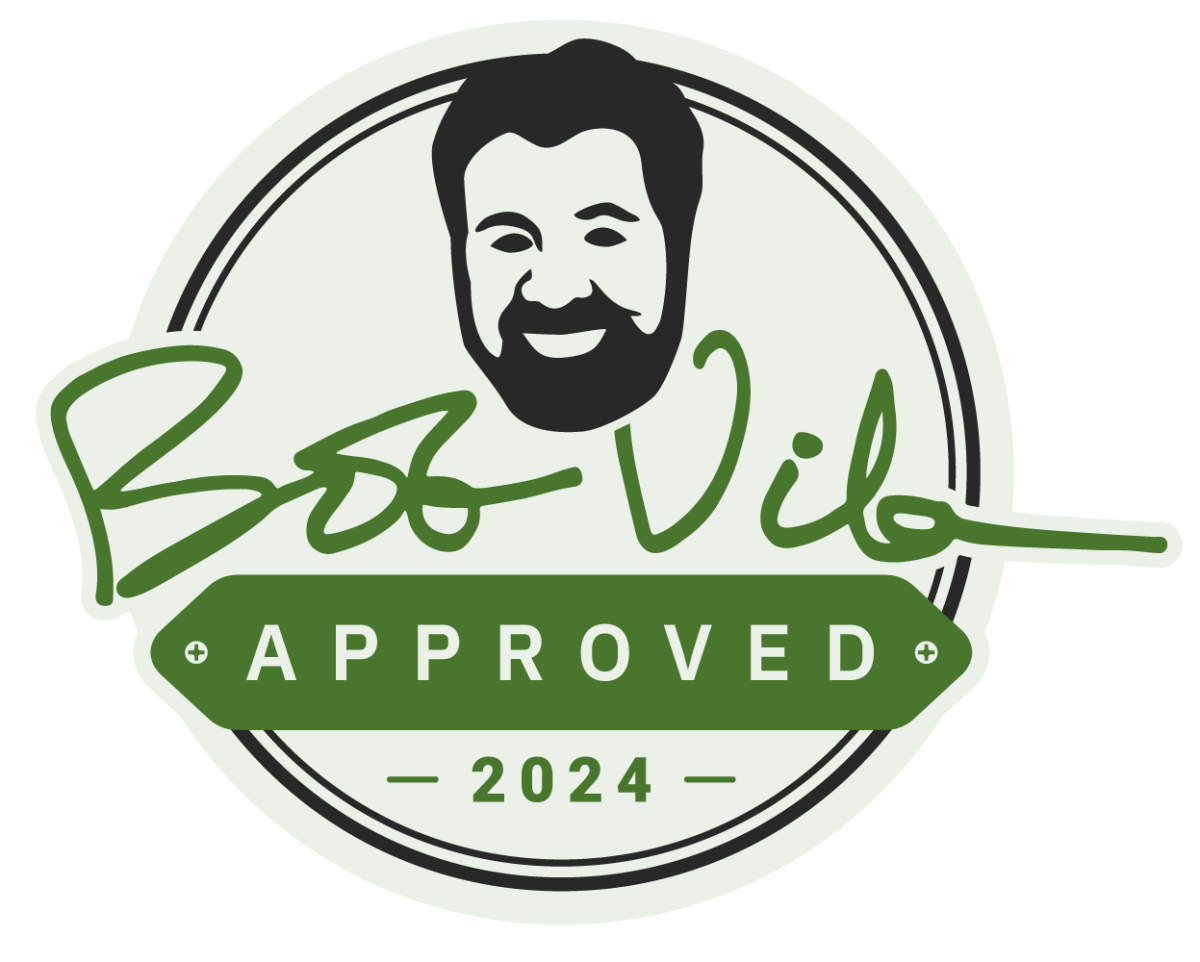
Bob Vila Approved recognizes the household and DIY products that impressed us most in our real-world testing and that exemplify core values of the Bob Vila brand, including craftsmanship, innovation, and value for the dollar. Winners of this designation come recommended by our professional review team and are personally approved by Bob Vila.
What We Like
- At 3.78 inches high, the RoboRock can navigate under several pieces of large furniture
- Advanced sensor technology effectively maps out rooms and keeps the vacuum from tumbling down the stairs
- Hands-free dustbin self-empties each time it returns to the dock, so vacuum is ready to go again
What We Don’t Like
- Only syncs with 2.4 GHz Wi-Fi; not compatible with 5 GHz networks
- Not suitable for high-pile shag rugs and carpeting
The RoboRock Q5+ took the top spot in our lineup, demonstrating high efficiency and a user-friendly app. The RoboRock deftly maneuvered around the room and under furniture. While it glided smoothly over most area rugs, it did get tangled in a high-pile shag rug, but we anticipated that—robot vacuums still are not made to clean long-fiber rugs.
Featuring 2,700 pascals (Pa), it efficiently picked up all the debris we scattered (rice and flour) and all visible pet hair. (For a more in-depth discussion of pascals, read the Suction Power section that appears after our product reviews.) Once the RoboRock had methodically cleaned every inch of exposed flooring, it automatically returned to its charging station and emptied itself into the canister bag, saving us the trouble of manual cleaning.
The RoboRock Q5+ boasts advanced features such as PreciSense LiDAR Navigation and a Sensient Sensor Array, so when it approached the top of the stairs, it detected the drop-off, stopped, and turned around. The wheels did not leave scuff marks or scratches on our hardwood floor. It comes with two dust bags, with the manufacturer claiming that one bag can hold up to 7 weeks of dust.
While we were able to sync the app to Alexa, it’s not required to run the RoboRock—and we actually found it more user-friendly to use the smartphone app. A small downside is that it operates only on 2.4 gigahertz (GHz) Wi-Fi. Folks whose wireless network runs on only 5 Ghz won’t be able to run this vacuum.
Overall, we found the RoboRock Q5+ to be a reliable and efficient cleaning companion, although it’s a bit pricier than competitive models.
Get the RoboRock robot vacuum at Amazon, The Home Depot, or Walmart.
Best Bang for the Buck
iRobot Roomba 675 Wi-Fi Connected Robot Vacuum
Product Specs
- Smart: Yes
- Mop: No
- Self-emptying: No
What We Like
- Very large brush roll integrated into the design; suitable for carpets as well as hard flooring
- Senses and eliminates areas with challenging amounts of dirt, pet hair, and other debris
- Reasonably priced considering its features and particularly good at cleaning cat and dog hair
What We Don’t Like
- Not self-emptying and removing the dirt bin is a bit tricky; may take a learning curve
Looking for a robot vacuum that won’t break the bank? This affordable model features a patented three-stage cleaning system and dual multisurface brushes to grab dirt from carpets and hard floors. Equipped with a full suite of sensors and just 3.54 inches high and 13.4 inches in diameter, the machine can clean under open-leg chairs and sofas without getting stuck. An Edge Sweeping brush handles corners while Cliff Detect keeps it from falling down stairs.
The iRobot Roomba 675 learns a user’s cleaning habits and can automatically create a customized cleaning schedule. The iRobot Home app will also suggest extra cleanings when the pollen count is high or during pet-shedding season. Boasting both Alexa and Google Assistant compatibility, it can start a cleaning session with voice commands.
The Dirt Detect sensor alerts the robot to tough cleaning areas, and the vacuum will tackle them thoroughly. It can operate for up to 90 minutes on a full charge and, when the battery runs low or the job is complete, the vacuum automatically returns to dock in its recharging station.
If an entry-level Roomba model is the goal, this is the one to pick. While the brand is known for its more expensive robots, this one is priced within reach. We were impressed not only with the smartphone app but also the suction. The dirt cup filled quite quickly, removing flour, pet hair, and kibble from the floor.
Get the iRobot Roomba 675 robot vacuum at Target or Amazon.
Upgrade Pick
Shark Detect Pro Self-Emptying Robot Vacuum
Product Specs
- Smart: Yes
- Mop: No
- Self-emptying: Yes
What We Like
- User-friendly app connects seamlessly with 2.4 or 5 GHz home wireless networks
- Methodical cleaning pattern effectively captures debris, leaving hard floors and rugs clean
- The self-emptying feature makes for a hassle-free cleaning experience
- Odor-neutralizing pod in the charging base provides a fresh scent to the base and the room
What We Don’t Like
- Eco mode is not quite strong enough to pick up pet hair on carpeting
We’ve had several Shark upright vacuums in the past that performed well, so we were excited to test the new Detect Pro, Shark’s latest addition to its robo-vac lineup. The initial setup was simple: We downloaded the app and it connected quickly to our home network. This model will connect to 2.4 or 5 GHz networks, making it suitable for most users.
We sprinkled flour and rice on several parts of the floor and got out of the Detect Pro’s way. After mapping out the floor perimeter, it proceeded to methodically vacuum back and forth in a stripe pattern to pick up all the debris, even bits that had fallen in the crevice between the edge of the area rug where it meets the floor. We were impressed.
We could choose from three different suction power modes: Normal, Eco, and Maximum. Normal was sufficient for cleaning up the rice and flour, but we needed Maximum to pick up stubbornly clinging pet hair from the carpet. Eco mode was best suited for picking up light dust from our tile and hardwood floors.
Its advanced sensing technology kept the machine from tumbling down the open stairway, and it seemed to know the difference between small bits of debris and wires—it picked up the debris and avoided the wires. The Shark Detect Pro was relatively quiet while cleaning, and when it was done, it returned to its charging station and emptied the debris into an internal vacuum bag.
A small but appreciated bonus is an odor-neutralizer pod that fits into the charger base and keeps the base from smelling sour, as some vacuums tend to do after repeated use. Every time the vacuum empties itself, air flows through the pod, giving the room a fresh scent.
Get the Shark robot vacuum at Amazon, Target, or Best Buy.
Best With Mop
Ecovac Deebot Omni Robot Vacuum and Mop
Product Specs
- Smart: Yes
- Mop: Yes
- Self-emptying: Yes
What We Like
- Functions effectively as both a powerful vacuum and a high-quality robot mop
- Automatically cleans its own scrubbing pads and self-empties the dustbin
- Spacious dustbin holds up to 70 days’ worth of dust, reducing bag replacement
- Efficient floor mapping capabilities and obstacle avoidance for better performance
What We Don’t Like
- Heavy weight at 40-plus pounds limits portability and may require a permanent setup location
With the advanced features of the Ecovac Deebot Omni, manually cleaning floors may soon be a thing of the past. First off, this is no wimpy robot vacuum. The shipping weight was 48 pounds, and when unboxed, the unit weighed a hefty 41.8 pounds—and that’s before filling the washing tank with water.
The Deebot Omni is a combo robot vacuum and mop and, unlike some other combo units we looked at, this model doesn’t just spray water and swish it around. It features two rotating scrubbing pads and it heats the mopping water for truly clean results. It dispenses hot water on the floor, scrubs, and then sucks up the dirty water. It did a good job removing light spots and stains.
The vacuuming is top-notch as well. It mapped out the floor plan and avoided wires, cords, and a pair of shoes that were inadvertently left in the test area. There are three suction modes for optimal efficiency that effectively picked up flour, rice grains, and pet hair on all three. The base boasts a large dust bag that Ecovac claims will hold up to 70 days of dust. When its tasks were done, the robot vac returned to its charging station and proceeded to wash its scrub pads, so we didn’t have to remove and clean them.
The app is user-friendly and synced quickly with our home network. We connected it to Alexa devices, but the app offers so many more options plus monitoring ability, so we preferred using it. Overall, the Deebot Omni is one heck of a robot vacuum, and we feel its advanced mopping features are a positive sign of where all robot vacuums will go in the near future.
Get the Ecovac robot vacuum at Amazon.
Best for Small Spaces
Eufy by Anker G30 Edge Robot Vacuum
Product Specs
- Smart: Yes
- Mop: No
- Self-emptying: No
What We Like
- Dynamic infrared navigation system integrated; remains aware of its surroundings, detects preset boundaries, and only cleans predesignated areas
- Impressive suction power compared to other vacuums on this list
- Transitions well between various types of flooring for ample versatility
What We Don’t Like
- Not suitable for high-pile carpets and very dark-colored floors
Neither carpeting nor low furniture can stop the Eufy by Anker G30 Edge. Its slim 2.85-inch-tall design fits under most furniture, while its large wheels ease transitions from hard flooring to low- or medium-pile carpeting. The Path Tracking Sensor ensures that the G30 Edge adapts to surface changes while taking the most efficient route to clean each room. Five included cable ties help keep wires and power cords out of the robot’s way. It features a 100-minute runtime—not as long as some of the other models we tested, but ample time to clean most small living areas.
An advanced brushless motor significantly reduces noise. Nine built-in infrared sensors ensure the G30 Edge remains aware of its surroundings, detects preset boundaries, and only cleans predesignated areas. Its 2,000 Pa of suction power delivers noticeably clean floors.
Users may control the G30 Edge with their voice via Alexa or Google Assistant. Helpful voice prompts indicate the robot vac’s current status and guide users through any problems that may occur. An app keeps track of its cleaning history.
While this vacuum showed impressive suction during testing, it had an odd movement pattern with grand diagonal sweeps. It also ran into larger obstacles, like a cardboard box and a sheepskin rug on the floor. However, it transitioned well between different types of flooring including hardwoods, carpet in the hallway, and an area rug in the living room. Still, the G30 Edge is an ideal choice for anyone with multiple types of flooring, especially if they are in a small space.
Get the Eufy by Anker G30 Edge robot vacuum at The Home Depot or Walmart.
Best for Large Spaces
Eufy Clean X8 Pro Self-Emptying Robot Vacuum
Product Specs
- Smart: Yes
- Mop: Yes
- Self-emptying: Yes
What We Like
- Powerful suction effectively picks up various types of debris as well as pet hair
- Self-emptying and reverse-spin roller technology cleans the vacuum and removes pet hair from roller
- Dual-function robot vacuum also performs light mopping on hard floors
- Remarkably quiet operation minimizes disturbances to humans and pets while cleaning
What We Don’t Like
- Light mopping does not suck up dirty water, so it is best suited to reasonably clean floors
The Eufy Clean X8 Pro is a formidable competitor in the robot vacuum realm, with a user-friendly app that made for easy connection to our wireless network. Its high-level suction power quickly picked up pet hair from our carpet, a task that usually requires two or three passes with a stick vacuum. At first, the X8 Pro skipped some rice at the edge of an area rug, but after vacuuming the adjacent room, it came back and picked up those errant grains, ultimately collecting all the flour and rice we spread out for testing before returning to its charging station.
Not only does the X8 Pro self-empty after vacuuming, but it also features a reverse-spin technology that effectively untangles any hair from its roller brush. Its dustbin bag has an up-to-45-day capacity (in a home with one pet) and features an antimicrobial bag.
In addition to powerful vacuum suction, the X8 Pro features light mopping action. It doesn’t suck up dirty water, however, so we found it best suited to floors that were already fairly clean and just needed a quick sprucing up.
The X8 Pro’s long runtime of up to 180 minutes makes it a good pick for large floor plans. This robot vacuum was also among the quietest we tested. Even the cats seemed more curious than perturbed! Indeed, one of our felines decided to lie on the test floor in the path of the X8 Pro. We hurried to pick her up to avoid a tangled fur situation, but we needn’t have worried; the robot vacuum must have sensed an object in its path because it came within about an inch of her tail and then reversed course.
Get the Eufy Clean X8 robot vacuum at Amazon.
Best for Pet Hair
iRobot Roomba i7 (7150) Smart Mapping Robot Vacuum
Product Specs
- Smart: Yes
- Mop: No
- Self-emptying: No
What We Like
- High-efficiency filter traps 99 percent of pet dander and allergens
- Works with Alexa for automated cleaning and hands-free use
- Recharges and resumes as needed based on the customizable presets
What We Don’t Like
- Runs a bit loud; may not be suitable around noise-sensitive pets or nighttime vacuuming
With a high-efficiency filter that traps 99 percent of cat and dog dander allergens, Alexa compatibility, and dual multisurface rubber brushes, this robot vacuum is perfect for homes with pets. It proved powerful enough to suck up pieces of errant kibble and cleaned deeply embedded pet hair from an area rug. However, our most serious messes required more than one go-around. Another pet-worthy plus is this model’s Keep Out Zones, which help it avoid sensitive areas, such as pet food bowls or areas where a puppy or kitten might be sleeping.
It does run a bit loud, however, and when it comes to large objects, it takes one or two tries before learning to avoid them. This model pairs easily with the app, which allows users to create a schedule, check the battery level, and more.
Get the iRobot Roomba i7 robot vacuum at Amazon, The Home Depot, or Walmart.
Jump to Our Top Picks
What to Consider When Choosing a Robot Vacuum
When selecting a robot vacuum, cleaning power is undoubtedly a priority, but the effectiveness of any model depends on a variety of factors, such as the size of the space, the type of flooring, battery life, and operation methods.
Coverage Area
When shopping for a robot vacuum, first consider the size of the home. Those with larger homes may want to consider a higher-end model with a longer runtime so that it can clean the entire house on a single charge. Some models can return to their charging dock to recharge and then go back out to finish the job, which is a mighty convenient feature in a large home.
For those who live in multistory homes, keep in mind that robot vacuums can’t climb stairs. Also consider whether the home’s flooring is primarily hardwood or carpeting. While robot vacuums are technically designed to handle bare floors as well as rugs and carpets, some perform better on certain flooring types.
Suction Power
The manufacturer might list the robot vacuum’s suction power in one of three measures: air watts; airflow in cubic feet per minute; or Pa, which are most commonly used.
The higher the Pa rating, the higher the atmospheric suction power of the machine. While manufacturers often use strong suction power as a selling point for robot vacuums, it isn’t actually a significant indicator of performance. Those with thick carpeting or high-pile rugs may require a robot vacuum with stronger suction.
Generally speaking, most models perform well at picking up dirt, dust, and pet hair from bare floors as well as low- and medium-pile carpet. As long as a robot vacuum features a Pa rating of 500 or higher, it’ll get most vacuuming jobs done.
Functions
Robot vacuums often include a selection of operating modes. “Turbo” modes offer quick and intense cleaning power; “eco” modes save battery power; and “quiet” modes won’t disturb others while they’re working, studying, napping, or watching TV. Some vacuums even offer programmable cleaning that can be scheduled in advance.
Some models also feature a built-in mop function, allowing users to clean tile and hardwood floors. They typically include a spray jet for dispensing water and floor cleaner as well as multiple cleaning pads for different types of flooring.
Operation
Along with a control panel, most robot vacuums come with a remote control to activate the vacuum when necessary or change the operating mode.
Many robot vacuums also connect to Wi-Fi for remote operation through an app. In addition to programming the machine, the app may also monitor the robot’s cleaning progress, battery life, and dustbin. More advanced models are compatible with smart-home systems that offer the same benefits, with the bonus of voice commands.
Battery Life
Regardless of its suction power, a robot vacuum won’t clean effectively without a properly charged battery. During an extensive cleaning cycle, some models will automatically dock in their charging stations until refueled and then continue vacuuming where they left off.
Manufacturers often list battery runtime and the area size (in square footage) that the vacuum will successfully clean on a single charge. Expect most robot vacuums to run for between 90 and 120 minutes before they need to be charged.
Additional Features
Some robot vacuums may come with a range of additional features to expand their functionality.
- Size and shape: Diameter does not vary much from one robot vacuum to another, but heights may range from 2.8 to 6 inches tall. A robot with a slimmer profile can access spaces around low furniture. The round shape of most robot vacuums enables easy turning and route patterns, while D-shaped models can turn flat for close cleanup along baseboards.
- Navigation: Those that land in the most affordable robot vacuum category function by simply bouncing off walls and furniture, operating in erratic patterns. Higher-end models actually perform digital mapping in order to recall a home’s floor plan and operate more efficiently.
- Self-emptying: Some robot vacuums empty the dirt and debris they collect into a receptacle in their charging docks, which only needs to be emptied every month or so.
- Smart-home integration: Some higher-end robot vacuums can sync with smart-home assistants like Amazon Alexa or Google Assistant, enabling voice commands to control the cleaning sessions.
FAQs
Read on for succinct answers to some of the most common questions about robot vacuums.
While many modern robot vacuums work well for light day-to-day cleaning, they still don’t quite compare to standard upright vacuums in terms of how much dust and debris they’re able to pick up.
The mapping function helps conserve battery power, which makes this feature convenient for larger homes. Mapping vacuums use their charge time more efficiently by avoiding cleaning the same areas more than once.
Robot vacuums with mops make a great choice for households with children and pets, where floors may benefit from more regular mopping.
The Ecovac robot vacuum is one of the best options on the market for those shopping for a robot vacuum and mop combo.
Meet the Tester
Glenda Taylor is a product tester and writer specializing in the construction, remodeling, and real estate industries. She and her husband own a general contracting company, and Taylor is experienced in both residential and commercial building applications. She tests a wide range of power tools as well as other home improvement, household, and lawn-and-garden products.
Additional research provided by Savannah Sher and Amanda Lauren.

